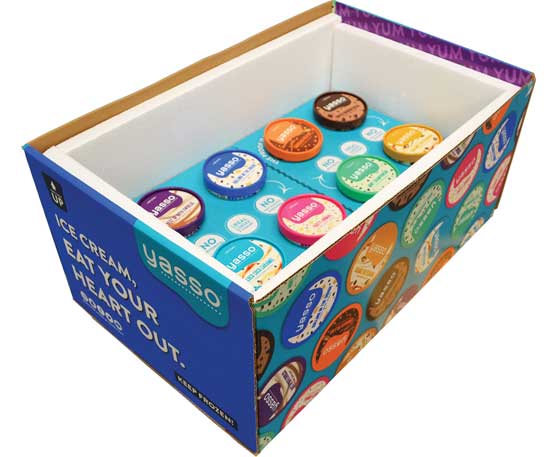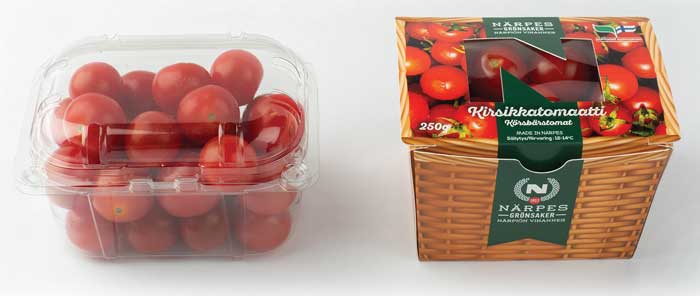The Future of Paperboard Is Bright
PACKAGING
Investments and innovations in the digital printing, design, and sustainability of paperboard packaging for the food industry make paperboard the most prevalent packaging material in the food industry. If future developments respond to consumers’ and food manufacturers’ need for increased shelf life and more personalization, then the future of paperboard packaging is bright.
 Digital Printing Provides Agility
Digital Printing Provides Agility
Advances in the quality and accessibility of digital printing on paperboard enable increased agility for food brands of all sizes. Printing large quantities of paperboard packaging without changing graphics or coatings is very cost-effective. However, high-volume printing limits the ability to package personalized, seasonal, and promotional products and ingredient changes. For example, rapid changes to graphics are needed when the formulation of product changes. As consumers’ purchasing becomes more aligned with production output and freshness and demand for certain ingredients increases, rapid ingredient changes are expected to increase. The need for agility in delivering packaged food to consumers has prompted major brands to switch to digital printing. As a result, brand packaging is more dynamic than ever before. Digital printing also facilitates printing labels and packages closer (in time and location) to product filling. Interestingly, digital finishing enhancements such as embossing or final detailed graphics permit personalization after high-volume printing. Moreover, this value chain alteration coupled with package production efficiency has opened market opportunities.
Consumers are now familiar with seeing packaging that relates to where they live and reflects current events. For example, when teams competing in a sporting event are determined, the packaging of certain foods may be digitally printed with team graphics. For example, paper-based bags of tortilla chips, printed with the logos of the teams competing in an NCAA final four tournament are in major grocery stores during the competition. Digital printing is also used for short production runs of printed cartons for test products, consumer package testing, and new product introductions. This allows more accurate test results. Distinctive corrugated containers and point of purchase displays can also be digitally printed with graphics personalized to consumers living in a region where the product will be shipped or displayed. For example, the gourmet popcorn brand Popcornopolis uses digitally printed displays made by Kaweah Container to market popcorn in seasonal packaging. Home Brewing Co., which employs client-specific labels as part of its marketing platform, applies digitally printed labels to its beer cans to deliver customization that customers appreciate.
Sustainability Adds Value
The sustainability of paperboard is complex and multifaceted. Recycling is a critical area of sustainability for the paperboard industry, which mostly uses trees as a fiber source. The use of alternative fibers from renewable sources that are less resource-intensive is increasing. Ocean and land litter associated with foodservice packaging is highly visible to consumers. More recyclable single-serve foodservice paperboard packaging has the potential to consume fewer resources than nonrecyclable packaging and to reduce litter. However, the recycling rate of foodservice packaging is only 2.5%, and few consumers have access to recycling services for foodservice packages. The drive to become a circular economy has focused packaging initiatives on increasing post-consumer recycling rates and increasing the use of post-consumer paperboard. For example, WestRock’s production facilities can now process foodservice paper-based coated packaging, and the company has successfully implemented curbside recycling of foodservice packaging. Both programs include plastic-coated paper coffee cups and coated cartons that are resistant to grease and oil. In recognition of its efforts, WestRock received the American Forest and Paper Association Sustainability Award in 2015, 2016, 2017, and 2018.
The proper disposal of foodservice packaging needs to be intuitive to consumers. This is essential to ensure that packaging is disposed of properly. For example, many foodservice operators conversion to paperboard-based straws is a critical opportunity to communicate to consumers that paper straws should be placed in garbage or recycling bins. Otherwise, if consumers dispose of paper straws as they did plastic straws, then paper straws will also have the potential to release compounds and emit carbon dioxide, nitrogen, and other greenhouse gases when they degrade. Some paperboard packaging is designed to be either recycled or composted, depending on the location of disposal. When paperboard cannot be recycled, industrial composting and home composting are environmentally friendly options. For example, Charta Global’s Bio Natura foodservice cups and cartons are certified as compostable by EN 13432 and are also recyclable. Because an infrastructure for industrial composting is not prevalent in the United States and other countries, products such as Bio Natura paperboard are often compostable at home.
Retailers support the use of more sustainable paperboard packaging. For example, since 2008, Amazon has used its Frustration-Free Packaging (FFP) program to guide vendors on how to design packaging that resonates with consumers. This includes right-sizing corrugated boxes for product shipping as well as packaging designed so that it does not need to be repacked before shipping. A new approach will monetize incentives for vendors who do not comply with FFP. Rational lifecycle analysis quantification tools can also be used to guide the sustainable sourcing and design of paperboard food packaging.
Material Properties Fuel Design Innovation
Because of the unique structural material properties of paperboard, there are several design opportunities. Defined shapes maintain their integrity and product viewing is controlled when rigid paperboard packaging is cut. For example, windows on chewing gum packaging allow consumers to see the inner wrapping, which communicates freshness. Textures and surface treatments on paperboard also relate to the consumer when the consumer cannot see a product through its package. The sensory properties of paperboard contribute to package design. “Brand owners have the opportunity to select packaging to support the product and the brand message,” explains Lee Stapleton, program development director of managed services, Sensory Spectrum Inc. “Good package design can foreshadow product characteristics for consumers and/or clearly communicate product expectations. For example, a smooth, slippery, and powdery-feel paper-based package for a cookie may set the expectation that the cookie has a meltaway quality. A rough pressed-paper bowl for a microwaveable meal may support a whole-grains message or that the product is sustainable. The value-add is using the package to promote the product, not just contain it.” Sensory scientists can provide quantifiable package development guidance by coupling objective measurement of package attributes with consumer research to interpret how specific texture, shape, and visual attributes impact consumer preference.
 Consumer research on paperboard packaging guides material choices as well. For example, in a recent study by Sense N Insight, Finnish consumers said they would pay more for tomatoes packaged in a Metsä Board paperboard carton. Presented as an alternative to plastic clamshell containers, the paperboard carton provided the same shelf life and was perceived as convenient and innovative; it also connected well with the quality image of the tomatoes. Package design can create a fun atmosphere. For example, the glow-in-the-dark stag o’lantern in a Jägermeister carton creates a memorable and haunting Halloween image.
Consumer research on paperboard packaging guides material choices as well. For example, in a recent study by Sense N Insight, Finnish consumers said they would pay more for tomatoes packaged in a Metsä Board paperboard carton. Presented as an alternative to plastic clamshell containers, the paperboard carton provided the same shelf life and was perceived as convenient and innovative; it also connected well with the quality image of the tomatoes. Package design can create a fun atmosphere. For example, the glow-in-the-dark stag o’lantern in a Jägermeister carton creates a memorable and haunting Halloween image.
Paperboard Food Packaging Has a Brilliant Future
Paperboard package printing, sustainability, design, barrier, adsorption, sterilization, and emission technology will advance paperboard food packaging dramatically. Water vapor barriers are already used on paperboard to inhibit warping and prevent adverse structural changes. To create paperboard that provides an oxygen barrier, developers are using dry-end nanotechnology, metalizing, glass coatings, and wet-end pulp processing technology to coat fibers before the Fourdrinier process. Research on the creation of functional barriers between recycled paper and virgin paper fibers within a paperboard package is promising and will allow for increased use of recycled paperboard in the food industry. Advances in the material science of primers improve the anchoring of inks to paperboard fibers, which will lead to using less ink to create crisp graphics.
The inherent ability of paperboard to harbor odors and flavors has been considered a disadvantage in paperboard packaging. However, this attribute can be used to create innovative packaging. For example, paperboard embedded with odor emitters and flavors can impart flavors and odors to products or mask off odors associated with lipid oxidation. There is great promise in this area since flavors often change during the shelf life of the product and may best be released closer to consumer use via diffusion from paperboard packaging. The release of antimicrobials from paperboard structures like the release of corrosion inhibitors from corrugated is also promising. With the use of low-temperature sterilization processes adapted from the food industry, post–food contact recycled paperboard can be made safe for direct food contact. This technology has the potential to drive the market for recycled paperboard and provide a more sustainable paperboard supply. Moreover, this sterilization process can address the lack of chain of custody associated with recycled paperboard.
 Claire Koelsch Sand, PhD, Contributing Editor
Claire Koelsch Sand, PhD, Contributing EditorCEO, Packaging Technology and Research
Adjunct Professor, Michigan State Univ. and California Polytechnic State Univ.
[email protected]
